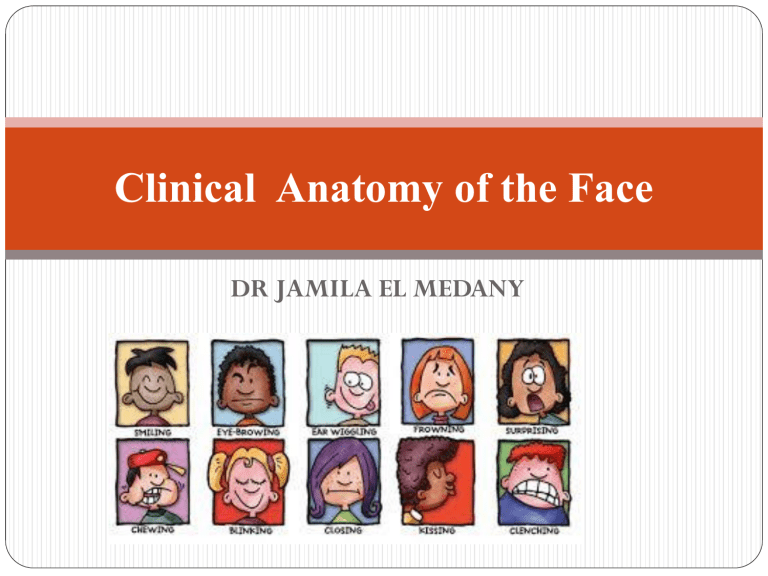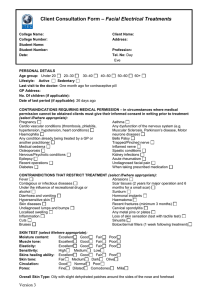
Clinical Anatomy of the Face DR JAMILA EL MEDANY Skin of the Face It is characterized by having numerous sweat and sebaceous glands. It is connected to the underlying bone by loose connective tissue. No deep fascia is in the face, because of this facial lacerations tend to gap. The skin must be sutured with great care to prevent scarring. The looseness of the subcutaneous tissue enables fluid and blood to accumulate in the loose connective tissue following bruising of the face. Similarly , facial inflammation causes considerable swelling. As a person ages, the skin loses its resiliency, as a result wrinkle lines and ridges occur in the skin perpendicular to the direction of the facial muscle fibers. Incisions along these wrinkle lines heal with minimal scaring. Cutaneous Nerve Supply The skin of the face is supplied mostly through the Trigeminal nerve (5th cranial), in front of the ear and partly through the Cervical plexus, behind the ear. OPHTHALMIC NERVE Supplies: Skin of the forehead. Upper eye lid & Conjunctiva. Side of the nose down to and including the tip. MAXILLARY NERVE Supplies: Skin of the posterior part of the side of the nose. Lower eye lid. Cheek & Upper lip . Lateral side of the orbital opening. Mandibular Nerve Supplies: Lower lip& chin. Lower part of the face &cheek. Temporal region. Part of the auricle, external auditory meatus and outer surface of tympanic membrane Great Auricular Nerve It is a branch of the cervical plexus (C2&3). It supplies the parotid sheath and the skin over the angle of the mandible. It is a sensory disorder of the sensory root of the CNV. The maxillary nerve is most frequently involved then the mandibular The pain is initiated by touching a sensitive trigger zone of the skin. The paroxysms can last for 15 minutes or more. Causes Treatment depends mostly on the use of & antiepileptic (AED) & antidepressant drugs (ADD) to relieve pain. In some cases section of the sensory root is necessary. Muscles of Facial Expression They are subcutaneous as they are embedded in the Superficial Fascia. They move the skin and change facial expressions to convey mood. Origin: Bones of the skull. Insertion: Skin of the face or mucous membrane. Action 1. Sphincters or dilators of the eyelids, nostrils and lips. 2.Modify the different expressions of the face to convey mood. MUSCLES OF THE EYE LIDS The Sphincter muscle is the Orbicularis Oculi. It has orbital part & palpebral part. Palpebral part : closes the eye lightly (as in plinking and sleeping). Orbital part : Closes the eye firmly (as in exposure to strong light). MUSCLES OF THE LIPS The Sphincter muscle is: Orbicualris Oris. Its fibers encircle the oral orifice within the lips. It is important during speech and compresses the lips against the teeth , working with the tongue to hold food between the teeth during mastication. The Dilator muscles radiate out from the lips and separate them: zygomaticus major, minor Risorus. MUSCLE OF THE CHEEK (BUCCINATOR) Origin: Alveolar margins of the maxilla &mandible and a raphe in between. Insertion: Upper fibers to upper lip. Lower fibers to lower lip. Middle fibers decussate: the upper part to the lower lip The lower part to the upper lip. Action: 1. Blowing. 2. Whistling. 3.Closes the vestibule of the mouth by compressing the lips and cheeks against the teeth. Occipito Frontalis The frontal bellies arise from the anterior part of the epicranial aponeurosis and is inserted into the skin of the eye brows. It elevates the eyebrows giving the face a surprised looking and produce transverse wrinkles of the forehead. Motor Supply Facial Nerve (7th cranial nerve). It gives motor supply to all muscles of facial expression. It does not supply the skin. Course & Distribution The facial nerve leaves the tympanic cavity by passing through the Stylomastoid foramen and enters the Parotid gland. Within the parotid gland: It passes forward superficial to retromandibular vein and external carotid artery. At the anterior border of the gland, it divides into its five terminal branches. Injury to the Branches of the Facial Nerve Because the branches of the facial nerve are superficial, they are subject to injury by stab, gunshot wounds, cuts and injury at birth. A lesion of the zygomatic branch causes loss of tonus of the orbicularis oculi to the lower eye lid, thus the lower eye lid drops and tears don not spread over the cornea, the dry cornea ulcerates, the resulting corneal scar impairs vision. Paralysis of the buccal branch prevents emptying of food from the vestibule of the cheeks Injury to the marginal mandibular branch may occur when an incision is made along the inferior border of the mandible as in surgical approach to the submandibular gland, it results in dropping of the corner of the mouth. Facial nerve paralysis(Bell’ s Palsy) It is paralysis (palsy) of the facial muscles due to injury of the facial nerve. The most common cause is idiopathic but it can results from exposure to cold , tumor of parotid gland, lacerations of the face. The palsy is due to weakens or paralysis of : Buccinator. Orbicularis Oris. Cheek and Lip muscles that aid chewing. Orbicularis oculi. Manifestations Manifestations Food accumulates during chewing and often must be continually removed by a finger. Patients frequently dab their eyes and mouth with a handkerchief to wipe the fluid (tears & saliva)which runs from the dropping lid and mouth. The fluid and constant wiping result in localised skin irritation. ARTERIAL SUPPLY The face has a rich blood supply so that it is rare for skin flaps in the face to necrose in plastic surgery. Facial wounds bleed freely but heal rapidly. It is supplied mostly through two branches of the external carotid artery: Facial. Superficial temporal. A small part of the face is supplied through the internal carotid artery ( supra orbital & supratrochlear branches) Course & Distribution of Facial Artery It arches upward deep to the submandibular salivary gland. It curves around the inferior margin of the body of the mandible at the anterior border of masseter muscle. It runs upward in a tortuous course to the angle of the mouth deep to the muscles. It ascends along the side of the nose to the medial angle of the eye. It terminates by anastomosing with the terminal branches of the opthalmic artery. Where to feel Facial Pulsation? As the artery crosses the inferior margin of the body of the mandible at the anterior border of the masseter muscle. Branches SUBMENTAL INFERIOR SUPERIOR LATERAL LABIAL LABIAL NASAL Compression of the Facial Artery The facial artery can be occluded by pressure against the mandible as the vessel crosses it. Because of the numerous anastomoses of the arteries of the face, compression of the facial artery on one side does not stop all bleeding from a lacerated facial artery or one of its branches. In lacerations of the lip, pressure must be applied on both sides of the cut to stop bleeding Superficial Temporal Artery It is the smaller terminal branch of the External Carotid Artery. It arises within the parotid gland and ascends in front of the auricle to supply the scalp. It gives the Transverse Facial artery that runs across the cheek just above the parotid duct. Where to feel Pulsation of Superficial Temporal artery? In front of the auricle as the artery crosses the root of the zygomatic arch. Anesthetists mostly depend upon the facial and superficial temporal arteries to take patient’s pulse. Facial Vein Where it begins? At the medial angle of the eye. How it is formed? By the union of the Supratrochlear & Supra orbital veins. Course: It descends behind the facial artery to the lower margin of the body of the mandible (superficial to submandibular gland). How it terminates? It is joined by the anterior division of the retromandibular vein to form common facial vein which drains into Internal Jugular Vein. Tributaries & Connections The facial vein receives tributaries that correspond to the branches of the facial artery. It is Connected to: (1) Pterygoid venous plexus through deep facial vein. (2) Cavernous sinus: through superior ophthalmic vein Blood from the nose, medial angle of the eye and lips usually drains inferiorly through the facial vein especially when the person is erect. Because the facial vein has no valves, blood may pass through it in the opposite direction so venous blood from the face may enter the cavernous sinus. Thrombophlebitis of the facial vein In patients with inflammation of the facial vein with secondary thrombus, pieces of the infected clot may extend into the intracranial venous system and produce thrombophlebitis of the cavernous sinuses. This may result from lacerations of the nose or by squeezing pustules on the side of the nose and upper lip What is the Dangerous Area of the Face? It is a triangular area bounded by: the side of nose, medial angle of the eye and upper lip.


